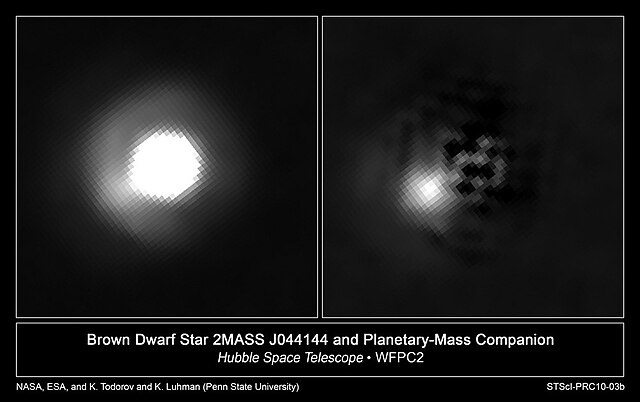PSR B1620-26 b is an exoplanet located approximately 12,400 light-years from Earth in the constellation of Scorpius. It bears the unofficial nicknames "Methuselah" and "the Genesis planet" due to its extreme age. The planet is in a circumbinary orbit around the two stars of PSR B1620-26 and is the first circumbinary planet ever confirmed. It is also the first planet found in a globular cluster. The planet is one of the oldest known extrasolar planets, believed to be about 12.7 billion years old.
An artist's impression of PSR B1620-26 b. Its parent stars are visible in the background.
The evolution of the PSR B1620-26 system.
An exoplanet or extrasolar planet is a planet outside the Solar System. The first possible evidence of an exoplanet was noted in 1917 but was not then recognized as such. The first confirmation of the detection occurred in 1992. A different planet, first detected in 1988, was confirmed in 2003. As of 1 May 2024, there are 5,662 confirmed exoplanets in 4,169 planetary systems, with 896 systems having more than one planet. The James Webb Space Telescope (JWST) is expected to discover more exoplanets, and to give more insight into their traits, such as their composition, environmental conditions, and potential for life.
Exoplanet HIP 65426b is the first discovered planet around star HIP 65426.
The three known planets of the star HR8799, as imaged by the Hale Telescope. The light from the central star was blanked out by a vector vortex coronagraph.
2MASS J044144 is a brown dwarf with a companion about 5–10 times the mass of Jupiter. It is not clear whether this companion object is a sub-brown dwarf or a planet.
Coronagraphic image of AB Pictoris showing a companion (bottom left), which is either a brown dwarf or a massive planet. The data were obtained on 16 March 2003 with NACO on the VLT, using a 1.4 arcsec occulting mask on top of AB Pictoris.






